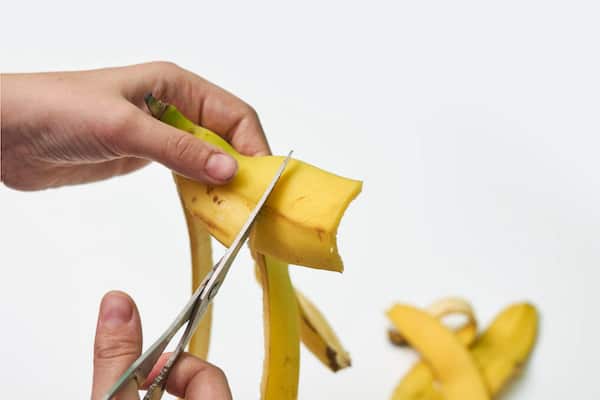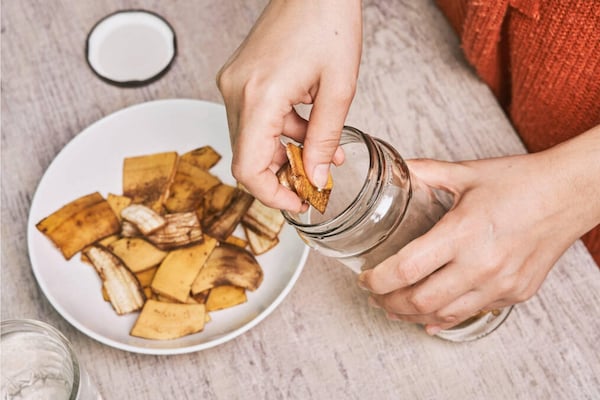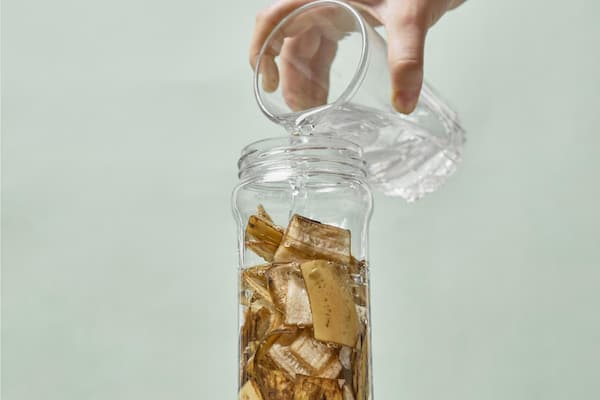Many gardeners swear by using banana peel water for plants, acting as a liquid fertilizer, but is it actually good or bad?
Bananas are a very common vegetable in the kitchen. Their peels contain many vitamins and minerals, but most importantly – potassium. Potassium is essential for plant growth.
Banana peels can be used to make liquid fertilizer to help with plant growth.
This article will discuss the advantages and disadvantages of banana peel water for plants, and how to make banana peel water.
What is Banana Peel Water?
Banana peel water is a nutritious drink to helps plants grow. It helps prevent deficiencies caused by low potassium levels that lead to brown leaves and curling leaf tips.
Banana peels contain potassium and manganese, which are vital to healthy plant cells. Vitamin C, dietary fiber, and manganese are also found in bananas.
Boiling banana peels will allow these minerals to leach out of the peels and become available as nutrient-rich water. The nutrients move into the water form the peels in the same way that tea and coffee are also made.
Even after boiling the banana peels to make banana water, some minerals remain in the peels. You can use the peels again on your plant as a slow-release fertilizer.
Watering using banana peel water to your plants can also be done effectively by using the bottom watering method, more on that below.
Banana Peel Water Benefits for Plants
There are many benefits of using banana peel water for your plants, especially with the nutrients that the banana water provides.
Nutrients and Minerals in Bananas
Bananas are a fruit that contains potassium, magnesium, manganese, sodium, and other minerals. These help regulate photosynthesis and promote green leaves. Bananas also contain potassium, magnesium, mananese, sodium, and many other minerals.
Here’s how various minerals benefit plants:
- Potassium – Potassium is an important mineral that promotes strong roots and stems. When plants have too little potassium, they tend to wilt easily.
- Magnesium – Magnesium is another important mineral that helps plants build strong cell walls and resist disease.
- Manganese – Manganese is necessary for photosynthesis, which means that plants need this element to convert sunlight into energy.
- Sodium – Sodium is required for the proper functioning of enzymes, metabolism and chlorophyll synthesis. Enzymes are responsible for breaking down food so that plants can absorb the nutrients.
- Iron – Iron is necessary for the formation of chlorophyll and for the production of oxygen that lets us breathe. Chlorophyll is necessary for green leaves.
- Calcium – Calcium for humans provides structural support for bones and teeth. It does the same thing for plants by helping provide strong cell walls.
Plants require nitrogen, phosphorous, potassium, and other nutrients to grow. Different types of plants need different amounts of each nutrient for optimal growth.
Banana peel water is an excellent source of nutrients. Bananas are one of the richest sources of potassium. Banana peels are rich in this mineral. But bananas and banana peels are not high in nitrogen and phosphorus. Plants need these nutrients for their growth.
The Benefits of Potassium in Plants
Potassium is an electrolyte and a mineral, which conducts electricity in your body. It’s classified as an essential nutrient because plants require potassium when it grows, and it’s essential for healthy functions. Plants require nitrogen and phosphorus to make fertilizers.
This is why, when purchasing fertilizer, you need to know the number affixed to each individual letter, indicating the available amount of the particular nutrient present in the fertilizer you’re buying.
Potassium Deficiency in Plants
When plants lack potassium, they become weak and susceptible to diseases. This makes them less likely to survive and thrive.
Potassium deficiency causes plant growth to be stunted. Banana peels contain high amounts of potassium, and using them on your plants can help prevent deficiencies.
You can tell if your plants are deficient in potassium by looking at their leaves. If the leaves appear yellowish or brownish, then your plants may be lacking potassium. Leaf tips may also start to curl because of the nutrient deficiency.
Potassium Helps Plants Fight Against Pests and Diseases
Potassium helps plants grow strong and healthy. It strengthens plants’ resistance to pests, diseases, fungi, and nematodes.
It also helps plants maintain a balance between the internal environment and external conditions. The more potassium in the soil, the better the chances of having healthier plants.
It will help strengthen plants’ resistance to drought, excess water and high and low temperatures.
Other Sources of Potassium Besides Bananas
Bananas are not the only, nor best source of potassium. Potatoes, beans, and other foods do contain more potassium than bananas comparatively.
But those other foods are messier to deal with when trying to utilize them in your garden. You have to wash, peel, cut, chop, cook, and dry all of the ingredients before you can use them.
With bananas, most people just decompose the banana peels into a compost bin or create banana peel water.
How to Make Banana Peel Water
You can make banana peel water either by boiling or soaking peeled bananas in water. This process draws the minerals out of the peels and into water.
To make banana peel water by boiling, follow these steps:
- Put the banana peels into a pot of water with about 1-2 inches of water above the banana peels
- Bring the water to a boil.
- Stir occasionally to allow all the peels to be exposed to the water.
- Boil the peels for 30 minutes.
- Strain the peels and let the water residue cool down completely.
- If the residue is thick, add water to liquefy the solution enough to use on the plants.
The other way to make banana peel water is through soaking, but it will take a longer time. Follow these steps:
- Place the banana peels into a bowl of water.
- Let the peels soak for at least 3-4 days. It’s best to soak for a week.
- Remove the banana peels from the water. Or you can strain the water out.
- The remaining banana peel water is ready to be used as a fertilizer.
Cutting the banana peels into smaller pieces will allow the nutrients to release into the water better.

Put the smaller pieces of banana peels into a jar.

Fill up the jar with water, up to a height that’s about 1.5 inches above the top of the banana peels.

I like to throw the leftover banana peels in with my worms in my vermicompost or directly into soil after pulverizing the peels.
Use Pulverized Banana Peels in Soil
Banana peels will still contain a good amount of minerals in the peels, so they can still be used directly into the soil. Pulverizing the banana peel into tiny pieces or a powder will allow it to break down quickly and release the nutrients into the soil for the plants.
Pulverizing increases the surface of the peels which allows for a faster release of nutrients into the soil. Breaking up the soil will allow for a quicker release of minerals into the ground.
There are several ways to do this, but first you’ll want to dry the peel. Drying the skin helps remove any remaining moisture and makes it easier to break apart.
You can dry the peels by putting it out in the sun or leaving it out to dry somewhere. After it’s dry, it’s time to pulverize the peels.
A blender works, just make sure you don’t add water to it as if you’re making a smoothie. Blending should only take a minute before it’s fine enough to use.
How to Use Banana Peel Water with Succulents
Banana peels contain minerals that help succulents grow. Succulents need water and nutrients, but they also need air. Succulents prefer to be watered by spraying them with banana peel water.
Succulents need to be misted regularly because they get too dry if they aren’t watered often enough. Banana peels are great for this purpose because they contain potassium and other nutrients.
You also need to worry less about overwatering when spraying succulents with banana peel water. The high mineral content in banana peel water will keep the succulents hydrated even during periods of drought.
Spraying succulents with banana peels will not harm the leaves. In fact, spraying the succulents with banana water will actually improve their health.
If you notice brown spots appearing on the leaves, then spray the succulents more frequently.
How to Mist Succulents with Banana Peel Water
Any household spray bottle can be used effectively. Peel water must be added to the spray bottle before spraying.
- Make sure the banana peel water is liquid enough and thin enough for it to come out of a spray. Thin the peel water out by adding more regular water.
- Spray the plant on the top and bottom of the leaves.
- It’s best to spray in the early morning hours before the sun comes out. The plants will be able to best absorb the nutrients and moisture before the water dries.
Spraying the topsoil also allows the plant’s roots to absorb moisture more easily.
How to Bottom Water with Banana Peel Water
Bottom watering is an effective method that ensures that the entire plant’s root system gets water without the risk overwatering your plants.
Here is how to bottom water using banana peel water:
- Get a flat container, similar to a drip tray, but higher on the sides, so water won’t spill out.
- Place the plant pot onto the container tray.
- Slowly pour banana peel water onto the tray, so the water reaches about 1 to 1.5 inches high.
- Let the plant pot sit in the water for 15-20 minutes. The bottom of the plant will start to absorb the water bottom-up during this time.
- Test the soil by sticking your finger about an inch into the soil to see if it’s moist. Once you find the soil is moist, you can remove the plant.
- When removing the pot from the tray, excess water will start to drip.
Bottom-watering trays are useful for keeping your plants watered. These trays are made of metal and plastic, and you can buy them online.
Plants that Banana Peel Water is Effective on
Banana peel water is effective on all types of plants, but the way that the water is applied will differ.
For example, succulent plants like aloe require frequent misting. If you don’t have access to a sprayer, then you can use a spray bottle.
Other plants, like orchids, benefit from being sprayed with banana peel water. Plants like tomatoes do not need to be sprayed with banana peel water as much as other plants. However, there are some plants that need to be sprayed with water every day. This includes annuals like petunias.
In general, if you have indoor plants, you can mist the plants, water from the top, and use the bottom watering technique with banana peel water.
For outdoor plants, use top watering and spraying.
Banana Peel Water Precautions
When using Banana Peel water in your garden, make sure that the water is at room temperature, and do not use boiling water.
It’s ok to boil the water to make banana peel water, but the water needs to cool down completely to room temperature.
Banana peels are a great fertilizer for plants. Care should be taken when watering them as overwatering can cause root rot and yellowing leaves. Bottom watering ensures that the plant gets enough water.
When misting, ensure that water is properly strained to prevent clogging of the nozzle. Add other fertilizers as needed when misting to give your plants the other nutrients they need.
Use Banana Peel Water as a Pesticide
Banana peels contain natural bacteria that help plants grow. Fermented banana peel water helps plants grow by encouraging beneficial bacteria. Insects dislike the smell of fermented banana peel water.
Fermented banana peel water contains beneficial bacteria which promote healthy roots. The smell of the fermented banana peel water keeps away unwanted pests such as iguanas, lizards, snakes, and fruit flies.
Insects like fruit flies, gnats, plant lice, and flea beetles will be irritated and even killed by the alcohol produced during fermentation.
How to Make Fermented Banana Peel Water
Making fermented banana peel water is easy. Follow these steps:
- Grab a free jar.
- Fill 3/4 of the jar with banana peel water.
- Add 1 teaspoon of sugar.
- Add 4 tablespoons of milk.
- Put the lid back on the jar and let it sit for 3 to 4 days.
- The solution will be translucent when it’s ready to use.
The solution works well for houseplants and gardens as a natural pest control.
Other Kitchen Scraps to Use as Plant Fertilizers
Banana peels aren’t the only food scraps that can be boiled or soaked in water to create plant fertilizer. Here are some other common leftover kitchen scraps that can be used:
- Apple cores
- Celery stems
- Carrot tops
- Corn husks
- Dried beans
- Garlic skins
- Ginger skins
- Leek greens
Banana Peel Water Final Thoughts
Banana peel water is an inexpensive way to add nutrients to your garden. It also makes a good natural pesticide.
To get more use out of them, after making banana peel water, you can grind up the used peels to spread on the soil. Or you can put the used banana peels into your compost pile.




